A question for you, for an upcoming article:
How do you decide when it’s time to add more greenhouse space? And how do you decide if you can afford it? What factors come into play? What math do you do?
I ask because in this day and age you can’t invest too much in new structures, especially with money costing as much as it does, and you can’t have structures sitting idle or costing you to heat or cool when they aren’t full. And after all, we are a peak-season business, with a large percentage of sales coming over just three or four months of spring.
Tell me your thought process! Give me an example from your latest expansion. Or perhaps you have put off expanding because the numbers didn’t pencil out. I want to know that, too.
Email me HERE. We can chat via phone, too. Just drop me a note if you have some ideas.
Thanks in advance!
JenZ@Plantpeddler
“Perfectly in the Middle of Nowhere.”
That’s how Mike Gooder describes the rural location of his wholesale business Plantpeddler—which, to be fair, IS in the middle of nowhere.
Cresco, Iowa, may be out there, but that didn’t matter to the close to 400 people who attended Plantpeddler’s 21st annual Variety Day Open House in early August. It was the highest attendance figure they’ve seen yet, and it tracks with how other events have been trending all year—up! Since January, every industry event and trade show in North America (national and regional) has seen record attendance.
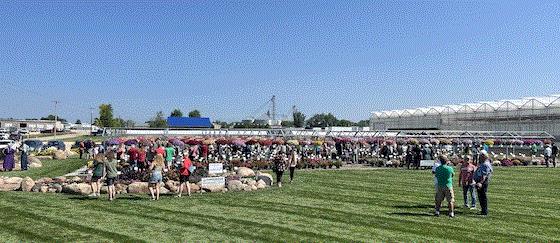 More than 400 people drove out to “perfectly in the middle of nowhere” to attend Plantpeddler’s 21st annual Variety Day Open House. Photos: Jennifer Zurko
More than 400 people drove out to “perfectly in the middle of nowhere” to attend Plantpeddler’s 21st annual Variety Day Open House. Photos: Jennifer Zurko
I asked Mike why he thought this was. He sat back, paused, and said, “That’s a good question!”
He thinks that more people are going out and attending events because they’re looking for moral support, especially in areas where Spring 2024 wasn’t great. Connecting with like-minded people who can offer advice or a shoulder to cry on helps you get through the hard times and move forward.
“A lot of people did not have a stellar season, but this is an industry that has a strong support system, that supports each other,” said Mike. “Maybe we’re all trying to be better together. We’re all going through the same challenges.”

@Plantpeddler (continued)

Plantpeddler’s trials only include vegetative varieties, so they weren’t able to include the original Sunfinity Helianthus from Syngenta. But the new Double Yellow IS vegetative, so they had it planted in one of the beds. It was the No. 1 favorite of the attendees.
The weather in Cresco provided a beautiful backdrop for people to chit-chat, network and peruse the 1,500 different vegetative varieties in Plantpeddler’s trial (700 in hanging baskets, 800 in containers). There’s a different theme every year and this year had two: the young plant supply chain and disease management. There were a handful of speakers on hand to present on both topics.
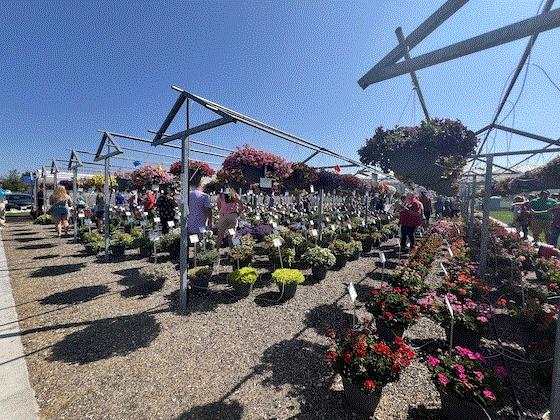
There were more than 1,500 different vegetative varieties in Plantpeddler’s trial (700 in hanging baskets, 800 in containers).
Mike said the Plantpeddler team works hard to provide a day that attendees feel gives them value, opportunities to gain more knowledge or learn something new, and to have fun. When you’re in the middle of nowhere, you gotta make it worth the long drive, and Mike doesn’t take that for granted.
“I feel very honored that people come from far away to be here,” he said. “I love bringing people together, and I have an amazing team. I’m super fortunate to have built a great company out here. It’s a blessing.”
Every year at the trials, visitors are encouraged to vote on their favorites. Here is 2024’s Top 10 (keep in mind that the trials only feature vegetative varieties—none from seed):
1. Helianthus Sunfinity Double Yellow (Syngenta)
2. Begonia I’conia First Kiss Del Sol (Dümmen Orange)
3. Osteospermum 4-D Blue Ice (Selecta One)
4. Begonia I’conia First Kiss Orange (Dümmen Orange)
5. Coleus TerraScape Queen (Kientzler)
6. Coleus Skeletal (Kientzler/Dynamic Plants)
7. Calibrachoa Lia Abstract Lemon Cherry (Danziger)
8. Begonia I’conia Portofino Citrix (Dümmen Orange)
9. (Tie) Portulaca SeaGlass Orange Shandy (Westhoff)
9. (Tie) Lobelia Magadi Compact Blue Bay (Selecta One)

Chris@The Landscape Show
I didn’t get such a good quote as Jen did during my quick visit to the opening day of The Landscape Show, the fall event of the Florida Nursery, Growers and Landscape Association, held at the Orange County Convention Center in Orlando. It’s just a 30-minute drive from my home, so how could I not go? Laurie came along to catch up with old industry friends and shop for our two acres of future gardens (we didn’t buy a booth, but it was tempting!).
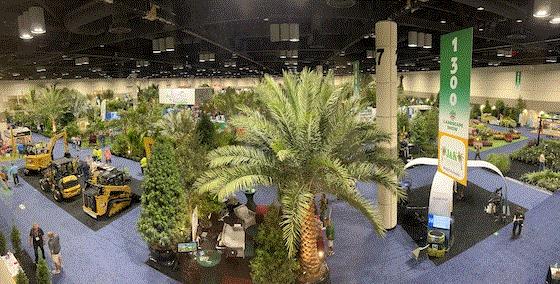
Our friend Linda Adams, COO of the association (until she retires next July; see next item) was staffing an info booth on the show floor, so I asked her for some info; namely, how was attendance looking? Excellent, she replied, at least based on pre-registration numbers. She said overall pre-reg was up about 18% over the previous year; and the all-important Buyer category was up 12%.
In addition, the already-large show had 55 more exhibitors. It’s not the biggest The Landscape Show ever, but the biggest in at least 10 years, she said.
That jibes with what we’ve been hearing and seeing at all our summer events: strong attendance and plenty of happy exhibitors, some of them first-timers.
It was too early in the show to ask exhibitors about how the show business was going, but business in general has been good this spring and summer, according to one landscape plant exhibitor from South Florida who specializes in large field-grown palms. His biggest problem is supply—demand is so strong, he is challenged with leaving product in the field long enough to get up to proper size. He’s planting an additional 30 acres due to strong demand.
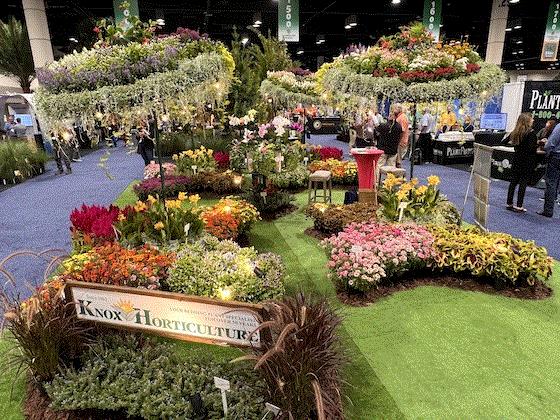
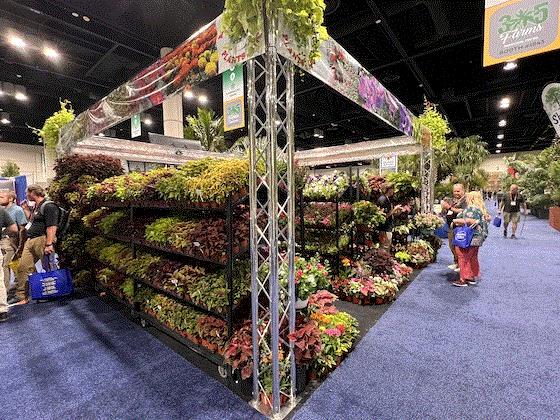
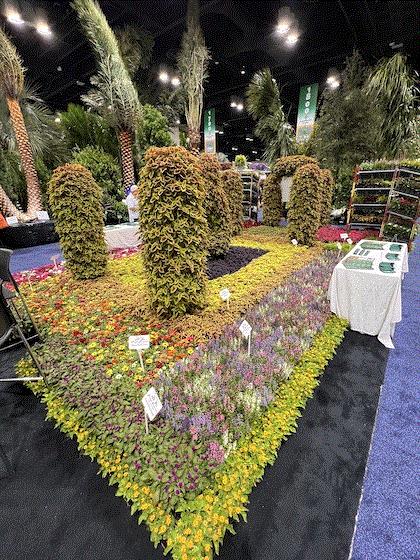 Even though The Landscape Show leans heavily toward woody and tropical landscape plants, including stately and impressive field-grown palms, the bedding plant world has good representation with Knox Horticulture, Brad’s Bedding and Bloom-Masters.
Even though The Landscape Show leans heavily toward woody and tropical landscape plants, including stately and impressive field-grown palms, the bedding plant world has good representation with Knox Horticulture, Brad’s Bedding and Bloom-Masters.

Shawn Pattison is new FNGLA COO
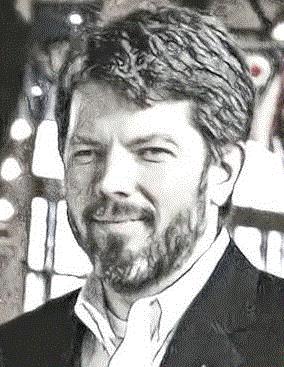
Linda Adams is petite, but she must wear Shaq-sized shoes, because her replacement, Shawn Pattison, is being given nearly a year to come up to speed before Linda officially retires and begins having even more fun than she has for the past 40 years with FNGLA.
Shawn seems to have the background to handle the responsibility, however. His previous roles include national field director for Concerned Veterans for America and vice president of operations at StandTogether. His expertise extends to consulting services driven by coalition building, advocacy and corporate public affairs. He is an alumnus of Hampden-Sydney College in Virginia and a veteran of the United States Coast Guard.
Lest you think he doesn’t know the difference between a croton and a crouton, not so! His early experience includes working on two tree farms, managing his own small landscaping business and planting an estate vineyard. Cheers, Shawn, and welcome to our industry!
A quick correction
Last time, I was given some misinformation about the funding that private equity firm Denver Angels is providing to online woody plant seller Bower & Branch. It’s not Series A funding as their initial press release stated, it’s Seed funding.
According to the financial geniuses on the Web, “Seed funding is the earliest stage of funding for a startup, while Series A is the first institutional round of funding.” Seed funding is generally a lesser amount, like in the low millions, while Series A gets into eight figures or more. No word on how much Bower & Branch has to spend, but perhaps we will see some more acquisitions in the coming months.
Who’s got plugs of AAS winners?
I think you should grow and sell All-America Selections winners, because they come with free and easy marketing tools. And they’ve been vetted by experts across the country.
Yet I hear your plaintive cries: “But, Chris, where can I get them? Who, for Pete’s sake, is growing the doggone plugs and liners?”
Well, let me tell you who is … or let me let AAS tell you. Because they’ve got a DOWNLOADABLE LIST on their website of participating young plant suppliers and the AAS Winners they are producing for the 2025 season. It includes all winners from 2005-2025 and includes some older, classic AAS Winners.
That same website also has a listing of wholesale seed suppliers, for those of you growing your own plugs.
This year’s list includes eight new growers, as noted by the asterisks. The young plant suppliers included in this year’s list are:
Ball Tagawa
Bob’s Market
*Cal Seedling
D.G.I. Propagators
*Dümmen Rooting Stations
Emerald Coast Growers
*Galema’s Greenhouse
Genesis Propagators (CAN only)
Geo. Sant & Sons
*GET Group
Green Circle Growers
Green Leaf
Gro N Sell
Gulley Greenhouses
Headstart Nursery
Jolly Farmer
Knox Horticulture
Kube Pak
Lucas Greenhouses
Mast Young Plants
Natural Beauty Plant Growers
*North Carolina Farms
Pacific Plug & Liner
Plantpeddler
Plug Connection
Raker-Roberta’s
Speedling
Sunbelt Greenhouses
Swift Greenhouses
Tagawa Greenhouses
Van de Wetering
VanWingerden International
VanVugt
Wagner’s
*Welby
Wenke Greenhouses
*Westcan Greenhouses
*Amos Zitel & Sons
Now here’s something that’s fun: I looked at the list, and the oldest AAS Winner on it dates back to 1941! That’s just nine years after the organization was founded, and just four years after George J. Ball published the first copy of my magazine. Any guess as to the variety? No. Nope. Wrong again. You’ll just have to check it out.

Misting options from Dramm
Back in the dark ages (the ’80s) when I was rooting my poinsettia cuttings, there were no commercial mist timers available—at least nothing I could afford. I had to make do with basic Intermatic swimming-pool time clocks cobbled together with a ragtag collection of contactors, bell wire and PVC. It worked … sort of.
I just got a blog post from Kurt Becker at Dramm that I would have loved to see 40 years ago. It’s about their various mist timers—all simple, and of varying capabilities, from one zone Bluetooth- and smartphone-controlled to more advanced multi-zone, multi-time operation. And they’ve got what you need to install clean, effective PE (polyethylene) tubing and misters over your benches, either on risers or suspended. He includes some interesting sample mist schedules based on how the climate changes during the day.
Check it out HERE.
Kurt, where were you 40 years ago when I needed you?!
Mastercourse alum explore Brazil’s floriculture
If you wonder where the next generation of floriculture leaders are, I can’t tell you … but I can tell you where they were last week: in Holambra, Brazil, at the first ever Mastercourse Meet Up, where 14 former attendees of Mastercourse got together for a five-day “Meet Up and tour of Brazilian floriculture.”
What is Mastercourse? It’s a two-week educational tour put on by Jungle Talks, a Dutch-based communications firm that hosts webinars, live events, educational opportunities and also these Mastercourse tours, which bring together top young (age 25 to 40) managers from around the world for two weeks of intensive exposure to and teachings from the best floriculture businesses in the world.
The 14 alum from previous Mastercourses represented Brazil, Canada, Kenya, Mexico, the Netherlands, Slovenia, Taiwan, Turkey and the U.S. They visited numerous production farms and institutions, and the Brazil flower auction, plus enjoyed some Brazilian culture and loads of peer networking time. They were all impressed by the professionalism of the floricultural sector in Brazil.
“It is my first visit, and I am truly impressed by the cooperative spirit and what they’ve built here since 1948,” said Marcel Boonekamp, production director for phalaenopsis at Green Circle Growers in Oberlin, Ohio, and a Mastercourse participant in 2023. “To me, Brazil has been a useful reference to what we’re doing in Ohio, maybe even more useful than the Netherlands.”
Harry Kruger, a 2019 participant from Kenya, added, “I signed up as soon as the announcement for this Meet Up was published, because I didn’t want to miss the chance of meeting again with former participants to the Mastercourse. From the moment we all arrived in Brazil we hit it off as if we have known each other for years already. It’s been very inspiring to learn more about Brazil and floriculture in this way, together with peers, to me that’s also the power of the Mastercourse concept.”
The Brazilian alumni say they were delighted to receive the international group and show them what is happening in Holambra.
“It’s been a great way to let people experience what we do here, how Brazil works and what it takes to build a business here,” said Simone van Oene of Joost Kalanchoe, another 2023 participant. “Multiple generations have been involved in building a blooming floriculture industry, and now the next generation is slowly taking over. I am proud to share how we do this.”
While visiting Veiling Holambra (the flower auction) all participants were also guests to the first Brazilian Young Grower of the Year award ceremony. Linked to the AIPH Young International Grower of the Year Award (YIGOTY), every year handed out during the IPM in Essen, Germany, Veiling initiated this national award to put young growers in the spotlight. Winner Gabriela Walravens of Flor y Ser won a spot in the upcoming Mastercourse Floriculture and will automatically compete for the AIPH YIGOTY award.
The next Mastercourse Floriculture is taking place from October 28 to November 8 in the Netherlands. Fifteen young floriculture managers will again make that educational journey.
For more on Mastercourse or Jungle Talks, click HERE.
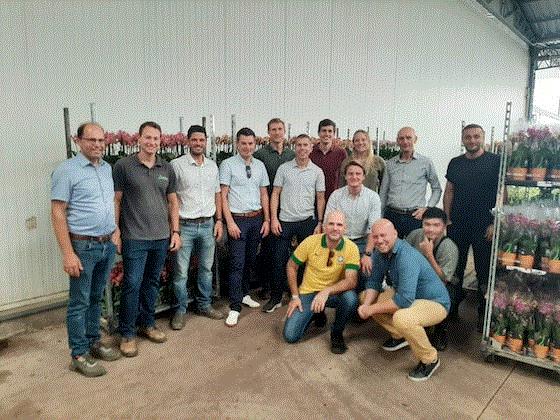 The Mastercourse alumni group at Symphony, a potted plant grower in Holambra, specializing in anthurium and hydrangea. Pictured (L to R):
The Mastercourse alumni group at Symphony, a potted plant grower in Holambra, specializing in anthurium and hydrangea. Pictured (L to R):
- Marko Viher, production director, Ocean Orchids, Slovenia
- Frank Barendse, production director, Symphony, Brazil
- Mattheus Yeda, production director, Sitio Kolibri, Brazil
- Arjan Noordam, production director, CosMic Plants, Canada
- Patrick Barendse, general manager, Symphony, Brazil
- Marcel Boonekamp, production director, Phalaenopsis, Green Circle Growers, U.S.
- Patrick van de Weyer, general manager, Ecoflora, Brazil
- Quinten Buijs, change manager, Sjaak Buijs, Netherlands
- Simone van Oene, marketing manager and part owner, Joost Kalanchoe, Brazil
- Geraldo Barendse, owner, Symphony, Brazil
- Taylan Ates, production director, Queen Turkiye, Turkey
- Shane Wang, production director, Royal Base, Taiwan/Vietnam
- Harry Kruger, rose grower, Kenya
- Dennis de Zeeuw, DQ Horti Soluciones, Mexico

Holambra: the rest of the story
Wish I’d been on the trip above! But I’m not under 40 or a Mastercourse alum … Regardless, curious about Holambra and where it is exactly, I Googled it … and Wikipedia taught me something very interesting, something that also explains the comment about 1948 above.
Holambra, which is a municipality in the state of São Paulo, is a mashup of the words Holland, America and Brazil. The colony of Holambra was founded in 1948 by Catholic Dutch immigrants.
You see, after the devastation caused by World War II, the Dutch government stimulated emigration to Australia, Brazil, Canada and France. Brazil was the only nation to allow the arrival of large groups of Catholics. With the consent of the Brazilian government, the Catholic Dutch Farmers and Market-gardeners Union (the “Katholieke Nederlandse Boeren-en Tuindersbond”) coordinated the emigration process.
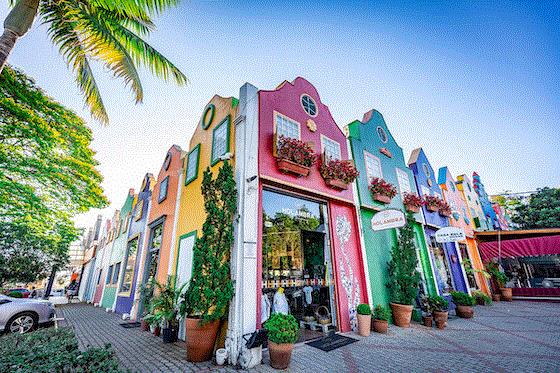
Editorial credit: Paulo Nabas / Shutterstock.com
A group of approximately 500 migrants from the province of North Brabant arrived in Brazil, establishing their first colony at the farm of Fazenda Ribeirão in the state of São Paulo. Holambra I was founded on July 14, 1948.
After a referendum in 1991 where 98% of the population voted in favor of political autonomy for the area, Holambra gained city status in January 1993 and now is a major tourist destination (as you can see from the photo).
And as the Mastercourse participants now know, too, Holambra is famous for its large production of flowers and plants.
This heavy Dutch influence is also the reason Holambra has a “veiling”— a Dutch-style flower-growers auction and cooperative.

Sidney B. Meadows Fund awards $24,000 in scholarships
The Sidney B. Meadows Scholarship Fund, created in 1989 by the Southern Nursery Association (SNA), has announced the names of 12 students from 10 southeastern universities chosen to receive academic scholarships this year. Eight of the awards are named scholarships honoring past industry leaders or loved ones. This year’s awards were $2,000 each, totaling $24,000. Here are this year’s scholarship recipients:
- Phiala Drake – Texas Tech University
- Landon Erbrick – Auburn University – Sally Smith Scholarship
- Kathryn Glenn– Clemson University – Arthur A. “Buck” Jones Scholarship
- Elliott Kenney – University of Maryland - College Park
- Cassie Marbach – Texas A&M University – Dr. James & Faye Foret Scholarship
- Grace Ramsey – Stephen F. Austin State University – Lee C. Howell Scholarship
- Charlotte Simmons – Tennessee Tech University – Dr. Bryson L. James Scholarship
- Meg Smolinski – University of Maryland – Art & Millie Lancaster Scholarship
- April Sprague – Oregon State University – Richard J. Hackney Scholarship
- Jonah Trevino – Texas Tech University
- Evan Villani – North Carolina State University
- Tyler Williamson – University of Georgia – Richard L. VanLandingham Scholarship
Scholarship recipients are determined through a competitive application process, administered by a selection committee, based on academics, determination, demonstrated interest in the horticulture industry and financial need. This year’s recipients were chosen from a very competitive group of applicants. Of the 12 students, seven are graduate students and five are undergrads.
With this year’s awards, the fund has awarded a total of $650,000 since the fund was established in 1989. The fund’s current assets are now more than $1,000,000.
The next round of scholarships will be available in early 2025. More details on scholarship eligibility can be found at www.sbmsef.org.

Finally …
Dr. Paul Fisher from UF, the newest SAF Alex Laurie Award winner, thanked me via email last week for the coverage, and I replied somewhat jokingly, “Well deserved, doctor! Now, what do you do for an encore.”
He had a great answer.
“Like many of us, as the proportion of grey hairs increase (and as the total number of hair follicles decreases—maybe that is something I should model) I am increasingly focused on supporting the next generation of growers. I think that will be my main legacy: providing access to training for the great hardworking people in our industry.”
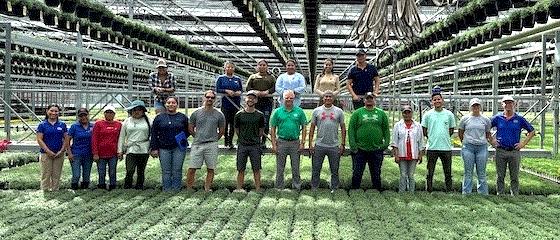
Paul was busy doing just that when he emailed. He was traveling with grad students, visiting growers; this week they were at Costa Farms’ Battlefield Farms location in Virginia, where he arranged this photo of himself (far right) with all the Battlefield employees who have graduated from UF’s Greenhouse Training Online classes this year. That’s 19 employees from one nursery in one year—Impressive!


Feel free to email me at beytes@growertalks.com if you have ideas, comments or questions.
See you next time!

Chris Beytes
Editor-in-Chief
GrowerTalks and Green Profit
This e-mail received by 28,912 loyal readers!
Thanks to my loyal sponsors, who help me reach the 28,856 readers of Acres Online in more than 60 countries. Want to be one of them (a sponsor, that is)? Give Kim Brown a shout and she will tell you about our many advertising opportunities.